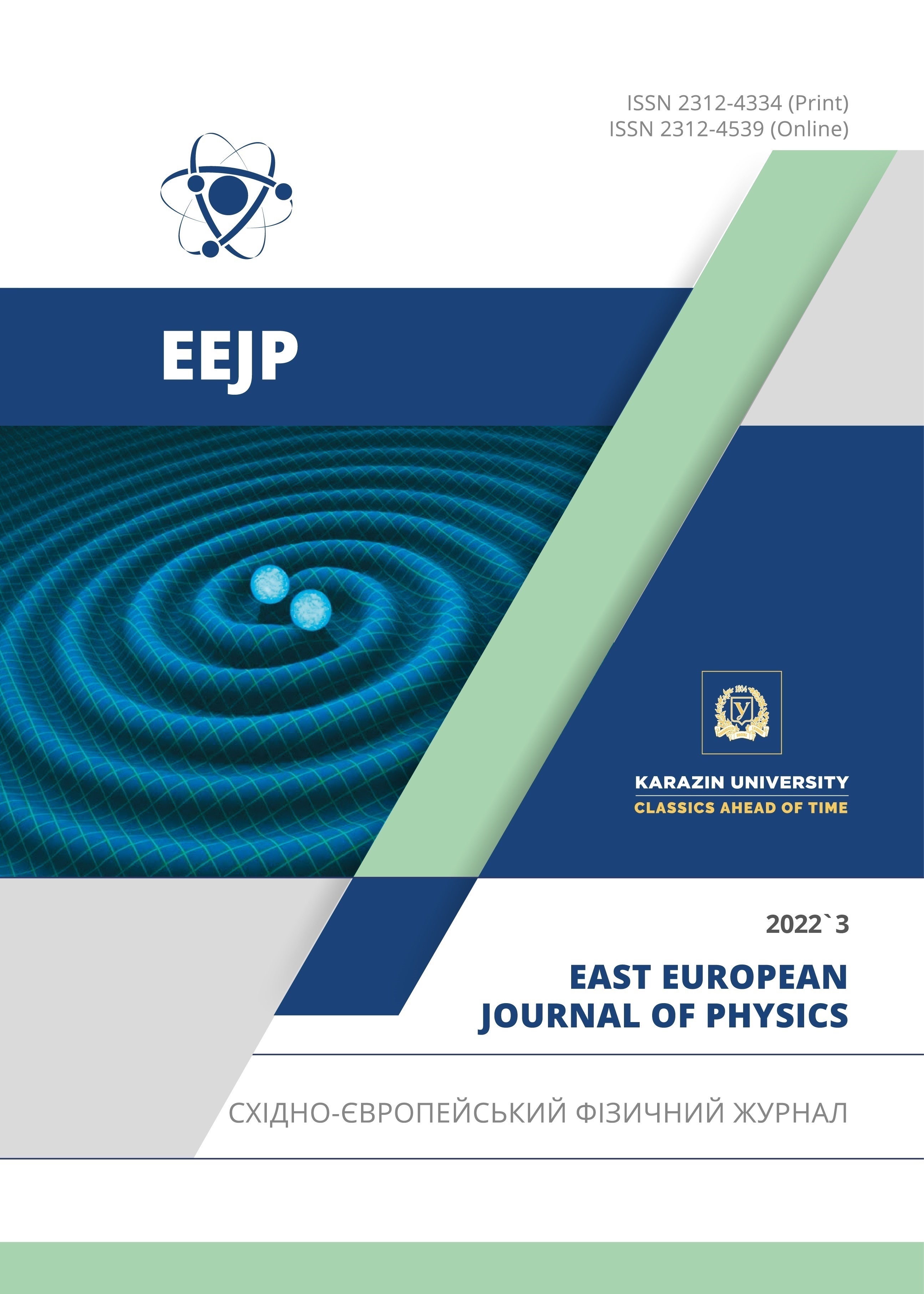Effect of Na Doping on Some Physical Properties of Chemically Sprayed CZTS Thin Films
Abstract
In this work, sodium-doped copper zinc tin sulfide (CZTS) thin films are prepared by depositing them on glass substrates at temperature of (400±10) °C and thickness of (350±10) nm using Chemical Spray Pyrolysis (CSP) technique. 0.02 M of copper chloride dihydrate (CuCl2.2H2O), 0.01 M of zinc chloride (ZnCl2), 0.01 M of tin chloride dihydrate (SnCl2.2H2O), and 0.16 M of thiourea (SC(NH2)2) were used as sources of copper, zinc, tin, and sulphur ions respectively. Sodium chloride (NaCl) at different volumetric ratios of (1, 3, 5, 7 and 9) % was used as a dopant source. The solution is sprayed on glass substrates. XRD diffraction, Raman spectroscopy, FESEM, UV-Vis-NIR, and Hall effect techniques were used to investigate the structural, optical, and electrical properties of the produced films. The XRD diffraction results revealed that all films are polycrystalline, with a tetragonal structure and a preferential orientation along the (112) plane. The crystallite size of all films was estimated using Scherrer's method, and it was found that the crystallite size decreases as the doping ratio increases. The FESEM results revealed the existence of cauliflower-shaped nanoparticles. The optical energy band gap was demonstrated to have a value ranging from 1.6 to 1.51 eV with a high absorption coefficient (α ≥104 cm-1) in the visible region of the spectrum. Hall measurements showed that the conductivity of CZTS thin films with various Na doping ratios have p-type electrical conductivity, and it increases as the Na doping ratio increases.
Downloads
References
A. Polman, M. Knight, E.C. Garnett, B. Ehrler, and W.C. Sinke, “Photovoltaic materials: Present efficiencies and future challenges,” Science, 352(6283), aad4424 (2016). https://doi.org/10.1126/science.aad4424
P. Jackson, R. Wuerz, D. Hariskos, E. Lotter, W. Witte, and M. Powalla, “Effects of heavy alkali elements in Cu(In,Ga)Se2 solar cells with efficiencies up to 22.6%”, Phys. Status Solidi, 10(8), 583 (2016). https://doi.org/10.1002/pssr.201600199
M.M.I. Sapeli, M.T. Ferdaous, S.A. Shahahmadi, K. Sopian, P. Chelvanathan, and N. Amin, “Effects of Cr doping in the structural and optoelectronic properties of Cu2ZnSnS4 (CZTS) thin film by magnetron co-sputtering”, Materials Letters, 221, 22 (2018). https://doi.org/10.1016/j.matlet.2018.03.056
K.I. Nakazawa, “Electrical and optical properties of stannite-type quaternary semiconductor thin films”, Japanese Journal of Applied Physics, 27(11), 2094 (1988). https://doi.org/10.1143/JJAP.27.2094
H. Katagiri, K. Jimbo, W.S. Maw, K. Oishi, M. Yamazaki, H. Araki, and A. Takeuchi, “Development of CZTS-based thin film solar cells”, Thin Solid Films, 517(7), 2455 (2009). https://doi.org/10.1016/j.tsf.2008.11.002
M. Buffiere, DS. Dhawale, and F. El-Mellouhi, “Chalcogenide materials and derivatives for photovoltaic applications”, Energy Technology, 7(11), 1900819 (2019). https://doi.org/10.1002/ente.201900819
S. Giraldo, Z. Jehl, M. Placidi, V. Izquierdo-Roca, A. Pérez- Rodríguez, and E. Saucedo, “Progress and perspectives of thin film kesterite photovoltaic technology: a critical review”, Advanced Materials, 31(16), 1806692 (2019). https://doi.org/10.1002/adma.201806692
P.S. Patil, “Versatility of chemical spray pyrolysis technique”, Mater. Chem. Phys. 59(3), 185 (1999). https://doi.org/10.1016/S0254-0584(99)00049-8
N. Nakayama, and K. Ito, “Sprayed films of stannite Cu2ZnSnS4”, Applied Surface Science, 92, 171 (1996). https://doi.org/10.1016/0169-4332(95)00225-1
Z. Laghfour, S. Aazou, M. Taibi, G. Schmerber, A. Ulyashin, A. Dinia, and Z. Sekkat, “Sodium doping mechanism on sol-gel processed kesterite Cu2ZnSnS4 thin films”, Superlattices and Microstructures, 120, 747 (2018). https://doi.org/10.1016/j.spmi.2018.05.018
Z. Tong, F. Liu, L. Jiang, and Y. Lai, “Improving the crystallization and carrier recombination of Cu2ZnSnS4 thin film deposited on Mo-coated soda-lime glass by extra sodium doping through solution process”. Materials Letters, 254, 50 (2019). https://doi.org/10.1016/j.matlet.2019.07.014
M. Marzougi, M.B. Rabeh, and M. Kanzari, “Effect of Na Doping on Structural and Optical Properties in Cu2ZnSnS4 Thin Films Synthesized by Thermal Evaporation Method”, Thin Solid Films, 672, 41 (2019). https://doi.org/10.1016/j.tsf.2018.12.046
C. Kittel, Introduction to Solid State Physics, (John Wiley and Sons Inc. 8th Edition, (2005).
B.D. Cullity, Elements of X-ray Diffraction, (Addison-Wesley publishing company, 1956).
E.M. Mkawi, “Kesterite Cu2ZnSnS4 Thin Films Synthesized Utilizing Electrodeposition: Influence of Metal Doping on the Properties”, International Journal of Energy Research, 45(2), 1908 (2021). https://doi.org/10.1002/er.5873
N.A. Bakr, S.A. Salman, and S.A. Hameed, “Deposition and Characterization of Cu2ZnSnS4 Thin Films for Solar Cell Applications”, International Journal of Applied Engineering Research, 13(6), 3379 (2018). https://www.ripublication.com/ijaer18/ijaerv13n6_32.pdf
D. Porezag, and M.R. Pederson, “Infrared Intensities and Raman-scattering Activities within Density-Functional Theory”, Physical Review B, 54(11), 7830 (1996). https://doi.org/10.1103/PhysRevB.54.7830
N.A. Bakr, Z.T. Khodair, and S.M. Abdul Hassan, “Effect of Substrate Temperature on Structural and Optical Properties of Cu2ZnSnS4 (CZTS) Films Prepared by Chemical Spray Pyrolysis Method”, Research Journal of Chemical Sciences, 5(10), 51 (2014). http://surl.li/crxgq
F. Zheng, X. Wen, T. Bu, S. Chen, J. Yang, W. Chen, F. Huang, and B. Jia, “Slow Response of Carries Dynamics in Perovskite Interface upon illumination”, ACS Applied Materials and Interfaces, 10(37), 31452 (2018). https://doi.org/10.1021/acsami.8b13932
Z.K. Yuan, S. Chen, Y. Xie, J.S. Park, H. Xiang, X.G. Gong, and S.H. Wei, “Na-Diffusion Enhanced p-type Conductivity in Cu(In,Ga)Se2: A New Mechanism for Efficient Doping in Semiconductors”, Advanced Energy Materials, 6(24), 1601191 (2016). https://doi.org/10.1002/aenm.201601191
C.Y. Liu, Z.M. Li, H.Y. Gu, S.Y. Chen, H. Xiang, and X.-G. Gong, “Sodium Passivation of the Grain Boundaries in CuInSe2 and Cu2ZnSnS4 for High-Efficiency Solar Cells”, Advanced Energy Mater, 7(8), 1601457 (2017). https://doi.org/10.1002/aenm.201601457
Authors who publish with this journal agree to the following terms:
- Authors retain copyright and grant the journal right of first publication with the work simultaneously licensed under a Creative Commons Attribution License that allows others to share the work with an acknowledgment of the work's authorship and initial publication in this journal.
- Authors are able to enter into separate, additional contractual arrangements for the non-exclusive distribution of the journal's published version of the work (e.g., post it to an institutional repository or publish it in a book), with an acknowledgment of its initial publication in this journal.
- Authors are permitted and encouraged to post their work online (e.g., in institutional repositories or on their website) prior to and during the submission process, as it can lead to productive exchanges, as well as earlier and greater citation of published work (See The Effect of Open Access).








